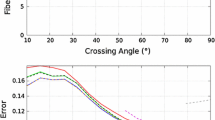Abstract
We present a rotation-equivariant self-supervised learning framework for the sparse deconvolution of non-negative scalar fields on the unit sphere. Spherical signals with multiple peaks naturally arise in Diffusion MRI (dMRI), where each voxel consists of one or more signal sources corresponding to anisotropic tissue structure such as white matter. Due to spatial and spectral partial voluming, clinically-feasible dMRI struggles to resolve crossing-fiber white matter configurations, leading to extensive development in spherical deconvolution methodology to recover underlying fiber directions. However, these methods are typically linear and struggle with small crossing-angles and partial volume fraction estimation. In this work, we improve on current methodologies by nonlinearly estimating fiber structures via self-supervised spherical convolutional networks with guaranteed equivariance to spherical rotation. We perform validation via extensive single and multi-shell synthetic benchmarks demonstrating competitive performance against common baselines. We further show improved downstream performance on fiber tractography measures on the Tractometer benchmark dataset. Finally, we show downstream improvements in terms of tractography and partial volume estimation on a multi-shell dataset of human subjects.
A. Elaldi and N. Dey—these authors contributed equally.
Access this chapter
Tax calculation will be finalised at checkout
Purchases are for personal use only
Similar content being viewed by others
Notes
- 1.
Contemporaneously to our work, [12] presents networks equivariant to spatial roto-translations and voxel-wise rotations with applications to dMRI lesion segmentation.
References
Canales-Rodríguez, E.J., Legarreta, J.H., Pizzolato, M., Rensonnet, G., Girard, G., et al.: Sparse wars: a survey and comparative study of spherical deconvolution algorithms for diffusion MRI. NeuroImage 184, 140–160 (2019)
Cohen, T., Welling, M.: Group equivariant convolutional networks. In: International Conference on Machine Learning, pp. 2990–2999 (2016)
Cohen, T.S., Geiger, M., Köhler, J., Welling, M.: Spherical CNNs. In: International Conference on Learning Representations (2018)
Daducci, A., Canales-Rodrıguez, E.J., Descoteaux, M., Garyfallidis, E., Gur, Y., et al.: Quantitative comparison of reconstruction methods for intra-voxel fiber recovery from diffusion MRI. IEEE Trans. Med. Imaging 33(2), 384–399 (2013)
Gorski, K.M., Wandelt, B.D., Hansen, F.K., Hivon, E., Banday, A.J.: The HEALPix primer. arXiv preprint arXiv:astro-ph/9905275 (1999)
Jeurissen, B., Tournier, J.D., Dhollander, T., Connelly, A., Sijbers, J.: Multi-tissue constrained spherical deconvolution for improved analysis of multi-shell diffusion MRI data. NeuroImage 103, 411–426 (2014)
Karimi, D., Vasung, L., Jaimes, C., Machado-Rivas, F., Khan, S., et al.: A machine learning-based method for estimating the number and orientations of major fascicles in diffusion-weighted magnetic resonance imaging (2020)
Lin, Z., et al.: Fast learning of fiber orientation distribution function for MR tractography using convolutional neural network. Med. Phys. 46(7), 3101–3116 (2019)
Liu, C., Wang, D., Wang, T., Feng, F., Wang, Y.: Multichannel sparse deconvolution of seismic data with shearlet-Cauchy constrained inversion. J. Geophys. Eng. 14(5), 1275–1282 (2017)
Lucena, O., Vos, S.B., Vakharia, V., Duncan, J., Ashkan, K., et al.: Using convolution neural networks to learn enhanced fiber orientation distribution models from commercially available diffusion magnetic resonance imaging (2020)
Maier-Hein, K.H., Neher, P.F., Houde, J.C., Côté, M.A., Garyfallidis, E., et al.: The challenge of mapping the human connectome based on diffusion tractography. Nat. Commun. 8(1), 1–13 (2017)
Müller, P., Golkov, V., Tomassini, V., Cremers, D.: Rotation-equivariant deep learning for diffusion MRI. arXiv preprint arXiv:2102.06942 (2021)
Nath, V., Schilling, K.G., Parvathaneni, P., Hansen, C.B., Hainline, A.E., et al.: Deep learning reveals untapped information for local white-matter fiber reconstruction in diffusion-weighted MRI. Magn. Reson. Imaging 62, 220–227 (2019)
Patel, K., Groeschel, S., Schultz, T.: Better fiber ODFs from suboptimal data with autoencoder based regularization. In: Frangi, A.F., Schnabel, J.A., Davatzikos, C., Alberola-López, C., Fichtinger, G. (eds.) MICCAI 2018. LNCS, vol. 11072, pp. 55–62. Springer, Cham (2018). https://doi.org/10.1007/978-3-030-00931-1_7
Perraudin, N., Defferrard, M., Kacprzak, T., Sgier, R.: DeepSphere: efficient spherical convolutional neural network with HEALPix sampling for cosmological applications. Astron. Comput. 27, 130–146 (2019)
Sedlar, S., Papadopoulo, T., Deriche, R., Deslauriers-Gauthier, S.: Diffusion MRI fiber orientation distribution function estimation using voxel-wise spherical U-net. In: Computational Diffusion MRI, MICCAI Workshop (2020)
Tong, Q., He, H., Gong, T., Li, C., et al.: Multicenter dataset of multi-shell diffusion MRI in healthy traveling adults with identical settings. Sci. Data 7, 157 (2020)
Tournier, J.D., Calamante, F., Connelly, A.: Robust determination of the fibre orientation distribution in diffusion MRI: non-negativity constrained super-resolved spherical deconvolution. Neuroimage 35(4), 1459–1472 (2007)
Tournier, J.D., Smith, R., Raffelt, D., Tabbara, R., Dhollander, T., et al.: Mrtrix3: a fast, flexible and open software framework for medical image processing and visualisation. NeuroImage 202, 116137 (2019)
Wedeen, V., et al.: Mapping fiber orientation spectra in cerebral white matter with Fourier-transform diffusion MRI. In: Proceedings of the 8th Annual Meeting of ISMRM (2000)
Yan, H., Carmichael, O., Paul, D., Peng, J., et al.: Estimating fiber orientation distribution from diffusion MRI with spherical needlets. Med. Image Anal. 46, 57–72 (2018)
Zhang, Y., Brady, M., Smith, S.: Segmentation of brain MR images through a hidden Markov random field model and the expectation-maximization algorithm. IEEE Trans. Med. imaging 20(1), 45–57 (2001)
Acknowledgements
Supported by NIH 1R01DA038215-01A1, R01-HD055741-12, 1R01HD088125-01A1, 1R01MH118362-01, R01ES032294, R01MH122447, and 1R34DA050287.
Author information
Authors and Affiliations
Corresponding author
Editor information
Editors and Affiliations
Rights and permissions
Copyright information
© 2021 Springer Nature Switzerland AG
About this paper
Cite this paper
Elaldi, A., Dey, N., Kim, H., Gerig, G. (2021). Equivariant Spherical Deconvolution: Learning Sparse Orientation Distribution Functions from Spherical Data. In: Feragen, A., Sommer, S., Schnabel, J., Nielsen, M. (eds) Information Processing in Medical Imaging. IPMI 2021. Lecture Notes in Computer Science(), vol 12729. Springer, Cham. https://doi.org/10.1007/978-3-030-78191-0_21
Download citation
DOI: https://doi.org/10.1007/978-3-030-78191-0_21
Published:
Publisher Name: Springer, Cham
Print ISBN: 978-3-030-78190-3
Online ISBN: 978-3-030-78191-0
eBook Packages: Computer ScienceComputer Science (R0)




